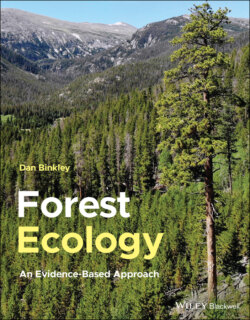Читать книгу Forest Ecology - Dan Binkley - Страница 44
Wind Shapes Trees and Forests
ОглавлениеForests have a complex relationship with wind. For example, wind moving past a leaf cools the leaf in two interacting ways. Leaves have a “boundary layer” of air that restricts the exchange of energy, water and CO2 with the atmosphere at large. Winds strip away the outer portion of the boundary layer, making it thinner and facilitating more transfer of energy and matter. How much does this matter? A leaf exposed to sunshine with no wind might have a temperature about 3–5 °C cooler in a breeze than in still air (as noted earlier in this chapter). If the tree is well supplied with water and the air's vapor pressure deficit is not a problem, the leaf would be another 3 or 4 °C cooler, for a total temperature difference of about 7 °C (Knoerr and Gay 1965). This difference in temperature in relation to wind (with interacting effects on transpiration) would be large enough to change photosynthesis and respiration in a leaf by 10–50% (Figure 2.4).
Moving from the scale of leaves and minutes up to trees and years, wind affects the way trees form stemwood. Trees may experience high wind if they grow in a windy location, or if they're at the edge of a forest with few sheltering neighbors. Tree crowns act like sails on ships, catching the wind and enduring very large forces that bend stems. Trees that are chronically exposed to strong winds develop a strong taper, broad at the base and thin at the top. Trees that are less exposed to wind have less taper, with tall slender stems that decline less in diameter going up the tree. Some of the windiest environments occur at high elevation, where crowns appear to be pushed to the downwind side of trees (flagging), or even pressed down close to the ground (krummholz, from German, “twisted wood”). The upper‐elevation limit of tree occurrence may relate as much to severe winds as to short growing seasons. High winds contribute great stresses in these extreme locations for trees, including wind‐blown ice crystals that damage leaves.
Trees experience “low‐to‐average” wind conditions most of the time, but severe wind events can bring forces on tree crowns that are higher than any time in the previous decade or century. When the severe event is not too far beyond the typical range, individual trees topple over, leaving gaps in the forest canopy and to some extent in the soil (Figure 2.20). Trees that blow over and create gaps typically are uprooted, with a large amount of soil raised up and a pit left behind. In other cases, the stem may resist the force of the wind less well than the roots, and the stem snaps off above ground. Severe wind events that greatly exceed typical storms, such as tornadoes, hurricanes and typhoons, can uproot or snap‐off most trees across large areas (Chapter 10).
FIGURE 2.20 Severe winds that are not too extreme may topple individual trees within a forest, leaving most of the canopy intact. High winds toppled many beech trees, and a few spruce trees, in this mixed forest in central Germany. Treefalls create gaps in the canopy that allows more light, water, and nutrients to be available for neighboring trees and understory plants (including small trees). Abrupt edges between harvested and unharvested forests can expose trees on the edge to higher winds, breaking off stems or uprooting trees (bottom left, Vancouver Island, Canada). Severe storms can level entire forests, breaking off stems of trees that are too solidly anchored to uproot, as in this former Scots pine forest in Poland (picture from one year after the storm.
Source: Skłodowski 2020 used by permission.
